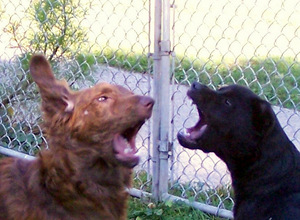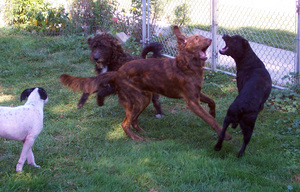Handling canine conflict at the dog park

Are these dogs fighting or playing? No peeking at the answer below!
Amy Samida | Contributor
The patter of little husky feet flying swiftly toward us caught my attention just as a silver blur shot past me. Ears forward, hair raised, tail stiffly curled, and up on her toes, she silently raced up to Ollie and they began circling each other.
Rocket, innocently anxious to meet the new dog, clambered up on to the shore, taking the attention of the husky long enough for me to step up and snap a leash on little Ollie, whose small size definitely put him at the greatest disadvantage. Moving Ollie away, I watched quietly for a minute, hoping to get a better read on this possibly aggressive interloper who had just shattered a golden moment.
The fact that this was a private dog park where dogs are given at least a rudimentary temperament test didn't make me feel a whole lot better. Dogs are dogs. They have bad days, reach social maturity, take an instant dislike to certain individuals and guard favored resources. Who knew what she was thinking?
Rocket was confused and unsure. It was hard. The mama bear protectiveness I felt made me want to rush in and save my beloved puppy. But I knew that IF an attack was in the offing, moving forward or yelling could tip the scale. My only safe action, it seemed, was to turn away and start walking, using a light, upbeat tone of voice to bring Rocket along. Hoping — hoping like you wouldn't believe — that my body language would bring my young, impulsive puppy along with me. It did. In an instant he was walking by my side.
Suddenly left behind, the husky again raced up, this time with a happily smiling mouth, wagging tail and loose body language. Rocket immediately responded to this clear cut invitation to play and the game was on. It was at that moment that a gentleman appeared in the field, panting and apologizing. With fleet of foot and keen of ear (dogs can hear a sound and identify its' direction in 1/600 of a second), his girl had heard us and left him in the dust.
Dog and man joined us for a walk along the paths, and I eventually trusted his girl enough that I took Ollie off the leash and let him romp, too. A fine time was had by all and I'm happy that Rocket found a new friend.
But do I trust her? Do you trust that guy your teenage daughter brought home? The one with the impeccable manners that you just know is sneering at you behind your back? This dog does love to swim, so maybe she resented the interlopers at “her” pond.
She changed remarkably the minute we headed away from the pond, but there could be other reasons for the change. Vapid though it may be, I don't want my precious puppy scarred since conformation shows are hopefully in his future, just to play with this dog; I won't let my guard down for a second. I'll be watching every dog he encounters throughout his life. I'll be watching him, too, for signs of aggressive behavior.
Sure, he's a leonberger, a breed known for sweetness of disposition, but he's not a lump, and he doesn't have to like every single dog he meets. It's my job to keep him, and them, as safe as I possibly can. For this reason I don't enter the dog park without a leash and a miniature air-horn in my pack, along with the poop bags and treats. The sharp loudness of an air horn can frequently stop a fight in its tracks with no harm to anyone. Go ahead, call me paranoid. I'm tough, I can take it.
And now the answer to the question of fighting or playing from the picture above. These boys are great friends. And they're playing, as you can see below. You can tell by their faces if you know what you're looking for. Since these guys are such good friends they engage in no-holds-barred play, and yet their faces are loose, ears are not pinned, lips are not pulled back, and there's no “whale eye” - a look where you see the whites of the eyes.

Did you get it right? They're playing!
Amy Samida | Contributor
Just like our own relationships where tempers can flare, dog tempers can flare, too, and bucolic moments can turn into a battle scene in a heartbeat. It means that the best of friends bear watching. The sight of a small dog dashing after a ball in the distance can shift a peaceable dog into "predatory drift" seemingly right out of the blue. I'll do a post on this topic one of these days, for now just know that predatory drift is the triggering of a dog, usually larger size, from passive to hunting mode. A split second is all it takes. A fight in one corner of a dog park can trigger satellite fights throughout the whole park.
These days, it's great to be a dog. Dog owners are meeting their dogs' physical and social needs far better than in days past. But with this increased socialization there are far more opportunities for things to go wrong. So don't skip that trip to the dog park or a play date, but do watch. Watch your dog and the dogs around her wherever you are. Skip the coffee and the chat with your dog park friends. Dog parks are places for dogs to socialize, but the humans? Not so much. Maybe you'll be lucky and your dog will go through his whole life with never a raised hair on his back, but the chances of that are slim.
Some common sense rules are to keep small dogs in the small dog area, if one is provided. Watch for dogs who guard balls or other toys and move your dog away to prevent friction. If any dog seems questionable, leave the park and go for a walk or come back later. If a fight does break out among other dogs, get your dog on a leash and, once again, leave the park. Dogs are quirky and nervous after a fight, even those who weren't involved. Come back a different day.
And, above all, if you KNOW your own dog can be a little iffy, don't put other dogs at risk, hoping for the best. Not all parks require a temperament test, they rely on owner's common sense. If your dog doesn't like to play with other dogs, pushing him to interact is stressful, not positive, and dangerous for the other dogs. Take him for a walk instead, do some training, and find other outlets for his activity needs.
Amy Samida is a dog trainer and owner of Naughty Dog Cafe. She can be reached at amy@naughtydogcafe.com or 734-276-3522.


Comments
hmsp
Sun, Jul 4, 2010 : 9:57 a.m.
Some good info there, and it's nice to know about your blog. I just read a bit over there, and will visit again soon. My general approach is a little less Type A, though, a little less Ann Arbor, perhaps (although I am a Townie). I'm a little more laisser-faire instead. Like my parenting approach, I guess -- I'm definitely not a helicopter type, and happily sent my kids off to play in the woods alone, as I used to do. And now, with a dog in my life after too long without, I'm playing at an informal Dog Party -- thirty or so dogs, thirty or so owners (yes, drinking coffee and chatting!). Enough it-takes-a-village eyes, though, that everyone either sees their dog pooping, or quickly hears about it from a friendly voice. Sure, there's a dog-tiff or two, just like any playground, but 99% of the time everything gets worked out just fine by the dogs themselves, who IMO, are much better at this stuff than humans -- the big dog that was playing a bit too rough gets a good snapping from the little dog, backs off a bit, then everyone goes back to playing. Of course, all conversation stops as the "parents" turn to see what is going on and see if intervention is needed -- some are quicker to intervene than others. That said, while the dogs are better than us at working this stuff out, if something DOES go wrong/get ugly, obviously that's when you need well-trained humans to intervene. So I'm all for smart training, and have nothing against an ounce of prevention... But I'd hate to see my Dog Party invaded by airhorns.
krc
Sat, Jul 3, 2010 : 10:15 a.m.
This is great information! Thanks so much! I had never heard the term "predatory drift" before. It explains so many things. I've tried to think about how to describe this behavior in posts about sudden pit bull attacks. I think these dogs are more prone to this. To change the subject (sort of): My daughter has a male neutered Yorkie who thinks he's a Pit Bull and is in attack mode whenever he is around big dogs. It's unfortunate for him because where he lives there is a Dog Beach on Lake Michigan where they all run free. He has to stay leashed. If you want to visit this Dog Beach, take 96 west all the way to it's end in Muskegon where it turns into Seaway Boulevard. Go to Sherman and turn left (Michigan turn) and follow it clear to the end. You'll see the entrance to the park on the left. Once you've gone down the ramps and steps, the Dog Beach is to your right.
rrt911
Fri, Jul 2, 2010 : 12:40 p.m.
Nice article and good advice. Your walking away was a great idea rather than entering into a situation where your dog might think he needed to stand for your honor or something. Keep 'em coming...